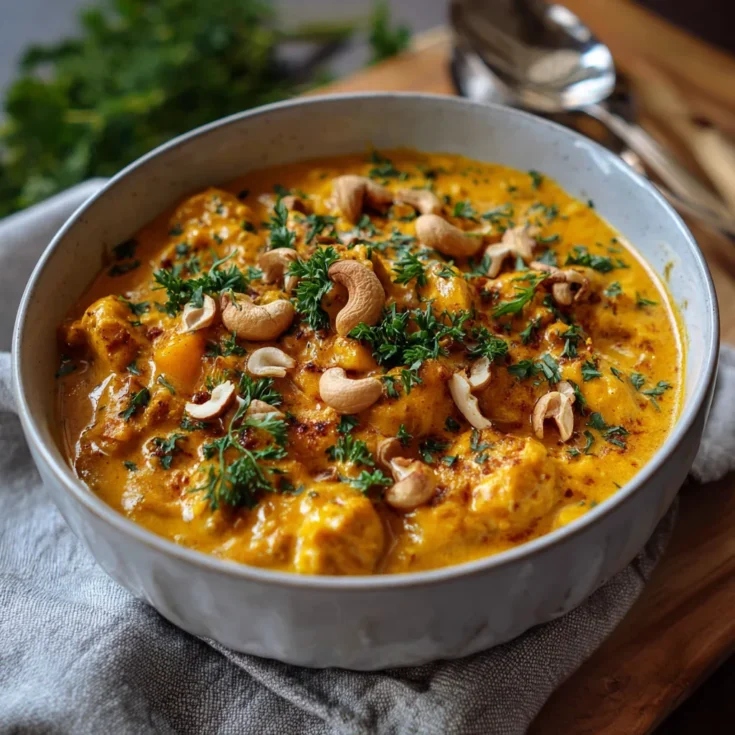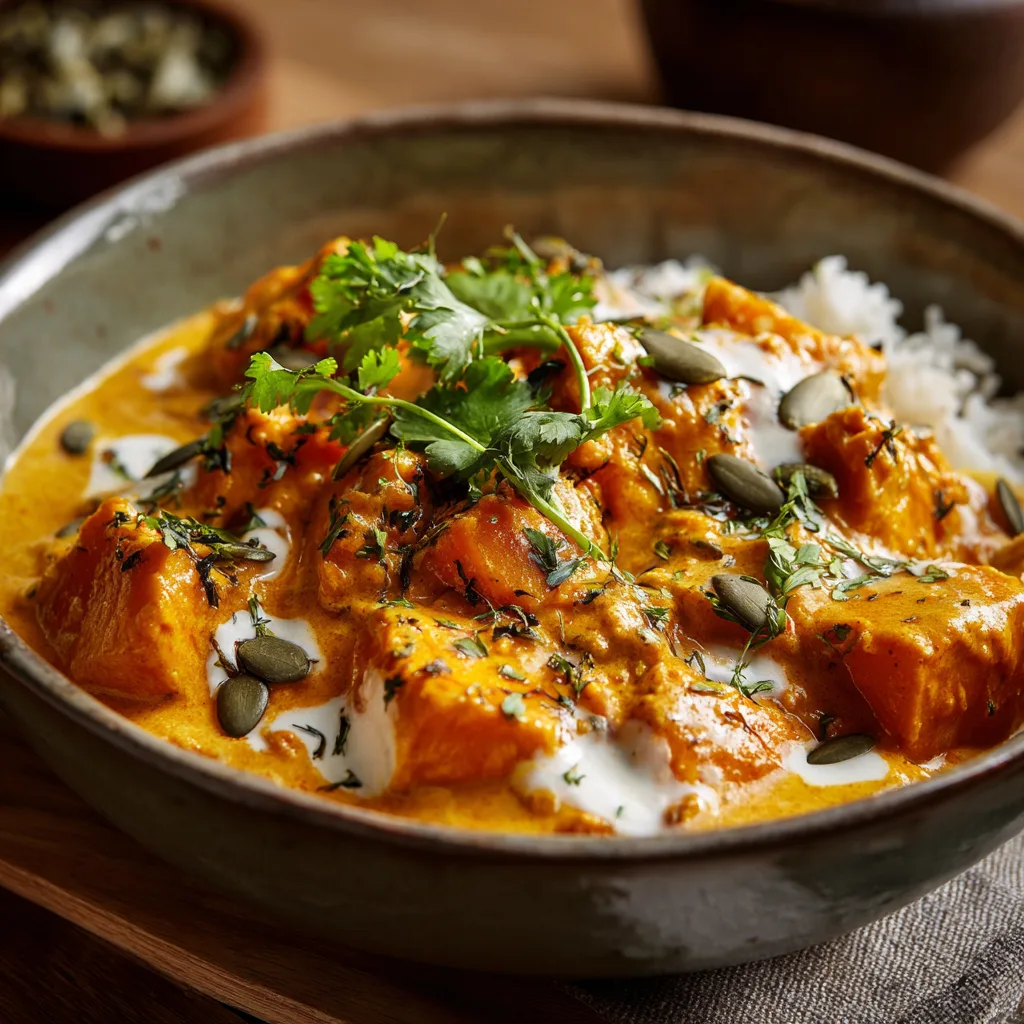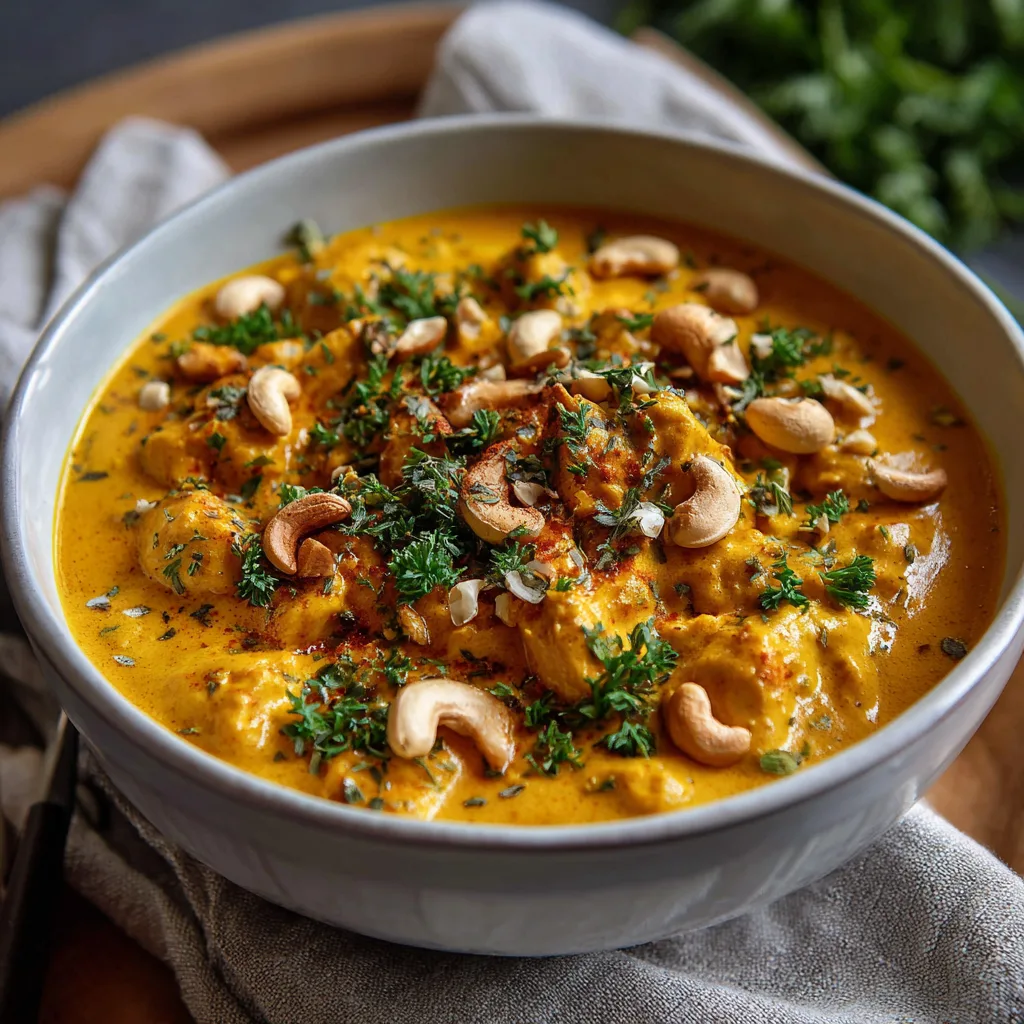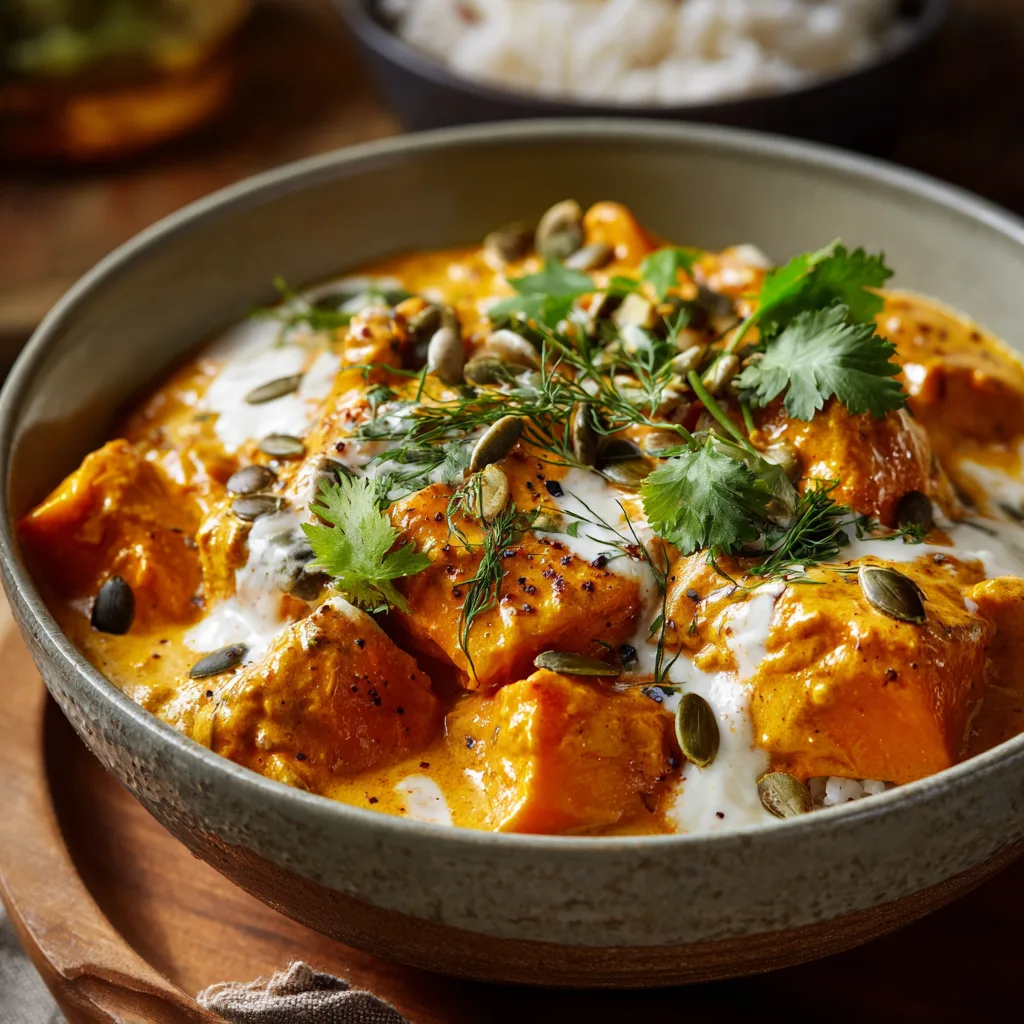No-Bake Creamy Pumpkin Curry
As the cooler months settle in, a warm, comforting meal becomes essential. No-bake creamy pumpkin curry offers a perfect solution. This dish saves you time and energy by skipping the oven. Instead, it relies on a stovetop method that delivers rich flavors with minimal fuss. Whether you’re short on time or just want a simple yet satisfying dinner, this no-bake curry fits the bill perfectly.
Creamy pumpkin curry usually combines smooth pumpkin purée or tender chunks with luscious coconut milk or cashew cream. Aromatic spices like turmeric, cumin, and ginger add depth, creating a flavorful and hearty dish. The creaminess balances the warmth of the spices, making every bite soothing and delicious.
Around the world, variations of pumpkin curry thrive. Indian recipes often use garam masala and mustard seeds. Thai versions incorporate red curry paste and fresh herbs, while Sri Lankan styles feature curry leaves and coconut in abundance. Each style celebrates pumpkin’s natural sweetness but with unique regional twists.
In this article, we will explore what makes no-bake creamy pumpkin curry so special. You’ll discover the key ingredients, methods, and tasty variations. Plus, we’ll share tips on how to make it your own with easy substitutions. Whether you’re a seasoned cook or a beginner, get ready to enjoy a simple, rich, and comforting curry perfect for chilly days.
Why This Curry Works: Pumpkin, Creaminess, and Spice Harmony
Pumpkin as the Star Ingredient: Sweet, Earthy, and Nutritious
Pumpkin shines as the heart of this curry, bringing natural sweetness and a creamy texture that thickens the sauce beautifully. Its earthy flavor complements aromatic spices, making each bite comforting and satisfying. Beyond taste, pumpkin packs a nutritional punch. It provides abundant vitamin A, crucial for eye health, and a healthy dose of dietary fiber that aids digestion. Rich in antioxidants, pumpkin also supports the immune system and helps fight inflammation. These benefits make pumpkin not only delicious but also a wholesome choice for a nourishing meal.
Creamy Texture Without Baking: Using Purees and Dairy-Free Alternatives
This no-bake recipe relies on pumpkin purée—either canned for convenience or fresh-made for a richer flavor. By skipping the oven, it streamlines preparation while preserving pumpkin’s natural creaminess. The dish achieves its velvety texture with dairy-free options like coconut milk, cashew cream, or almond milk. Coconut milk adds a tropical sweetness and luscious mouthfeel, enhancing the curry’s richness. Cashews blended into a smooth paste offer a subtle nuttiness and thick consistency. These plant-based creams keep the curry light yet indulgent, appealing to vegans and those avoiding dairy alike.
Spice Base and Flavor Profile: A Global Blend of Aromatics
The curry’s signature warmth comes from carefully chosen spices. Indian versions typically use turmeric, cumin, and garam masala, which bring earthy, smoky, and mildly spicy notes. This spice trio layers complexity into the curry’s flavor, complementing pumpkin’s sweetness. Thai-inspired recipes lean on red curry paste combined with fresh ginger and garlic, adding heat and zing. Meanwhile, Sri Lankan variations incorporate fragrant curry leaves, creamy coconut bases, and fenugreek seeds, which contribute subtle bitterness and depth. Together, these spices create a harmonious balance of flavors that makes the pumpkin curry vibrant and memorable.
Ingredients and Variations: Building Your Perfect No-Bake Pumpkin Curry
Core Ingredients: The Foundation of Flavor and Creaminess
At the heart of any creamy pumpkin curry lies the pumpkin itself. You can choose fresh pumpkin, peeled and cubed, which offers a vibrant, natural sweetness and a satisfying texture. Alternatively, canned pumpkin purée provides convenience and consistent creaminess without extra prep time. Pair pumpkin with rich coconut milk or creamy cashews to achieve that luscious texture. Aromatics such as onion, garlic, and ginger add layers of flavor, while your choice of curry paste or powder sets the spice profile. Whether you prefer an Indian garam masala blend or a Thai red curry paste, these core ingredients create a solid base for a rich, comforting curry.
Protein and Vegetable Add-Ins: Boosting Nutrition and Texture
Pumpkin curry easily adapts to include a variety of proteins and vegetables, making it a versatile meal option. Chickpeas and tofu are excellent plant-based proteins that absorb spices beautifully while adding hearty texture. Vegetables like sweet potato, cauliflower, and broccoli complement pumpkin’s sweetness with their mild flavors and add nutritional variety. For those who enjoy meat, chicken thighs offer juicy richness and work well in Indian or Thai-style pumpkin curries. Shrimp adds a light, briny contrast, especially in Southeast Asian variations. These options allow you to tailor the curry to your taste and dietary needs.
Dietary Adaptations: Catering to All Preferences and Restrictions
One of the strengths of pumpkin curry lies in its flexibility for different diets. It naturally suits vegan and vegetarian lifestyles when using plant-based creams and proteins. Gluten-free diets benefit from this recipe as it contains no wheat or gluten-containing ingredients. Nut allergies can be accommodated by substituting cashew cream with coconut milk or almond milk alternatives. Soy-free versions simply avoid tofu and soy sauce, focusing on legumes or meats instead. This adaptability ensures everyone can enjoy a bowl of creamy, spiced pumpkin goodness regardless of dietary restrictions.
Regional Flavor Twists: Exploring Global Pumpkin Curry Traditions
Pumpkin curry showcases exciting regional differences, reflecting diverse culinary traditions. Indian recipes often take the form of kaddu ka bharta—a mashed pumpkin curry flavored with mustard seeds, cumin, and fresh herbs. Sri Lankan wattakka kalu pol adds blackened coconut for smoky depth and a unique coconut flavor, creating a richer, more textured dish. Thai versions emphasize red curry paste combined with lemongrass and kaffir lime leaves, bringing bright, zesty notes to the creamy base. Caribbean plant-based styles often incorporate allspice and scotch bonnet peppers, offering warmth and a subtle kick. These twists inspire endless variations to keep your pumpkin curry fresh and exciting.
Method and Process: How to Make No-Bake Creamy Pumpkin Curry
No-Bake Method Basics: Stovetop Simplicity, No Roasting Required
This no-bake creamy pumpkin curry simplifies your cooking process without sacrificing flavor. You won’t need an oven or any roasting trays. Everything comes together in one pot on the stovetop, making cleanup easier and prep more efficient. The ingredients cook gently, allowing the flavors to meld while keeping the texture tender and creamy. This method works especially well for busy nights or small kitchens. With minimal prep and no baking involved, you’ll have a hearty curry ready in less than 40 minutes.
Step 1 – Prep Aromatics and Spices: Build the Flavor Base
Start by heating a bit of oil in your pan or Dutch oven over medium heat. Sauté chopped onions until soft and translucent. Next, add freshly grated garlic and ginger. Stir until aromatic, about one minute. These form the flavor backbone of your curry. Add your curry powder or paste next. Toasting the spices briefly in oil intensifies their flavor and removes any raw edge. This step unlocks the full complexity of the spice blend, giving your curry a deep, well-rounded taste.
Step 2 – Add Pumpkin and Protein or Vegetables: Make It Hearty
Once your aromatics are golden and fragrant, stir in the pumpkin. If you’re using purée, fold it in until evenly mixed. For fresh pumpkin cubes, add them and stir to coat with the spice base. Now’s the time to add your chosen proteins and vegetables. Chickpeas, tofu, or diced chicken thighs work perfectly here. You can also toss in vegetables like cauliflower or sweet potatoes. Mix everything thoroughly, letting the flavors coat each component.
Step 3 – Add Liquids: Create a Creamy, Rich Sauce
Now it’s time to pour in your liquids. Full-fat coconut milk gives the curry a luxurious, rich texture and slightly sweet flavor. Light coconut milk creates a thinner, lighter sauce but still delivers a creamy feel. Add water or vegetable broth to loosen the consistency as needed. If you prefer a slightly tangier base, stir in tomato passata or a spoonful of tomato purée. These additions create a more vibrant color and deepen the savory notes of the curry. Stir well to combine all ingredients and ensure nothing sticks to the bottom.
Step 4 – Simmer and Thicken: Let the Flavors Come Together
Reduce the heat to low and cover the pot. Let your curry simmer gently for 15 to 25 minutes. This allows the pumpkin to soften (if using cubes) and the other ingredients to absorb the flavors. The sauce will naturally thicken as it simmers. If it feels too thin, mash some of the pumpkin with a spoon or blend a portion using an immersion blender. For an even thicker result, stir in a cornstarch slurry during the last five minutes of cooking. Taste and adjust the seasoning before moving to the final step.
Step 5 – Finish and Garnish: Add Brightness and Crunch
Once your curry reaches the desired consistency, remove it from the heat. Add a splash of lime or lemon juice to brighten the flavors and balance the richness of the coconut milk. Garnish with chopped fresh cilantro for a pop of color and freshness. For added texture, sprinkle toasted cashews or pumpkin seeds over each serving. These garnishes elevate the dish and provide a satisfying contrast to the creamy base. Serve hot with your favorite grain or flatbread.
Equipment and Prep Tips: Keep It Simple and Efficient
You’ll only need a few tools for this no-bake curry. A large sauté pan or Dutch oven is ideal, offering enough depth for all ingredients to simmer evenly. Use a wooden spoon or silicone spatula to stir and scrape the bottom of the pot. If you prefer a silky-smooth texture, an immersion blender helps achieve that with ease—just pulse directly in the pot. For faster prep, use pre-chopped aromatics or canned ingredients. This dish is also meal-prep friendly. It stores well in the fridge for up to five days and reheats beautifully. Make a double batch and enjoy throughout the week.
Storage, Serving & Reader Q&A: Make the Most of Your No-Bake Creamy Pumpkin Curry
Serving Suggestions: Pair Your Curry Like a Pro
No-bake creamy pumpkin curry is rich and satisfying, making it the perfect centerpiece for a balanced meal. Serve it over basmati or jasmine rice for a classic pairing that absorbs the flavorful sauce. For a grain-free or protein-rich option, try quinoa—it adds a nutty bite and complements the creaminess. You can also pair it with naan or flatbread, which are great for scooping up the thick curry. A fresh side salad—like cucumber-tomato with lemon dressing—adds crunch and brightness to the meal. With so many options, you can easily adapt the dish to suit any craving or occasion.
Storage & Reheating: Keep It Fresh for Days
No-bake pumpkin curry stores well, making it an excellent choice for batch cooking. In the fridge, it stays fresh for 3 to 5 days when kept in an airtight container. For freezing, divide it into portions and use freezer-safe containers. The texture may change slightly upon thawing, especially if you used soft vegetables or tofu, but the flavor will remain delicious. To reheat, place the curry in a saucepan over low heat. Stir in a splash of water or coconut milk to loosen the sauce if it has thickened too much. Heat gently, stirring often to avoid scorching, and serve once warmed through.
FAQ : “People Also Ask”
How long does pumpkin curry last in the fridge?
Pumpkin curry keeps well in the fridge for 3 to 5 days in a sealed container. Reheat gently before serving.
Can I use fresh pumpkin instead of canned purée?
Yes! Fresh pumpkin works beautifully. Choose cooking varieties like sugar pumpkin or kabocha. Dice them small for faster cooking.
What is the best type of pumpkin for curry?
Sugar pumpkins, kabocha, calabaza, and butternut squash all work well. They’re sweet, dense, and hold their shape during cooking.
How do I thicken the curry if it’s too thin?
You can blend a portion of the curry or stir in a cornstarch slurry. Both methods help achieve a thicker, creamier texture.
Can I freeze pumpkin curry?
Yes, but note that some textures may change. It’s best to freeze firmer versions with chickpeas or chicken rather than soft vegetables.
No-Bake Creamy Pumpkin Curry – 15-Minute Cozy Vegan Dinner

A rich and comforting curry featuring pumpkin and a creamy coconut or cashew sauce. Made entirely on the stovetop, this one-pot dish delivers bold, warm flavors without the need for an oven.
Ingredients
- 1 tablespoon oil (coconut or olive)
- 1 small onion, finely chopped
- 2 cloves garlic, minced
- 1 tablespoon grated ginger
- 2 tablespoons curry powder or red curry paste
- 2 cups pumpkin purée or 2 cups peeled, cubed cooking pumpkin
- 1 cup cooked chickpeas or cubed tofu (or cooked chicken/shrimp)
- 1 can (13.5 oz) full-fat coconut milk
- ½ cup vegetable broth or water
- 1 teaspoon salt (adjust to taste)
- Optional: ½ cup tomato purée or passata
- Fresh cilantro for garnish
- Toasted cashews or pumpkin seeds for topping
- Juice of ½ lime or lemon
Instructions
☐ Heat oil in a large saucepan over medium heat
☐ Add onion, garlic, and ginger; sauté until soft and fragrant
☐ Stir in curry powder or paste; toast for 1–2 minutes
☐ Add pumpkin purée or cubes and stir to coat
☐ Mix in protein (chickpeas, tofu, chicken, or shrimp)
☐ Pour in coconut milk and broth (plus tomato if using)
☐ Bring to a simmer and cook 15–25 minutes, until thickened
☐ Optional: Blend part of the curry for a smoother texture
☐ Add lime or lemon juice, taste and adjust seasoning
☐ Garnish with cilantro and toasted nuts or seeds
Notes




